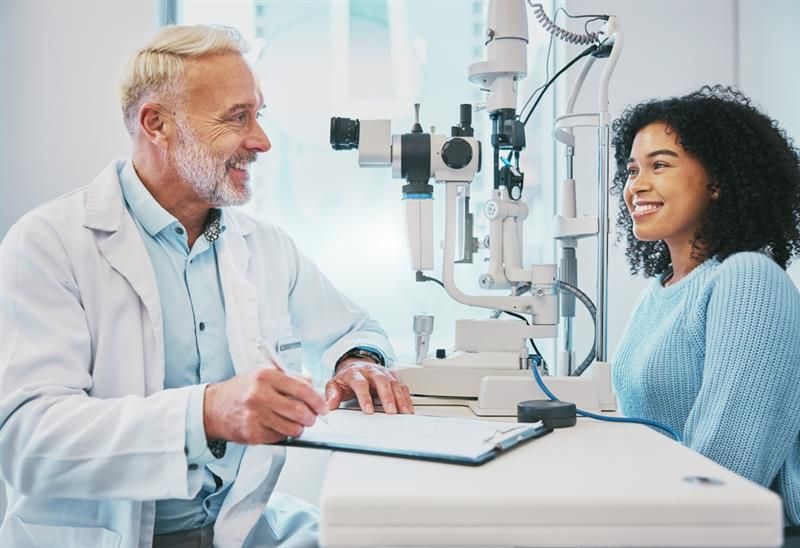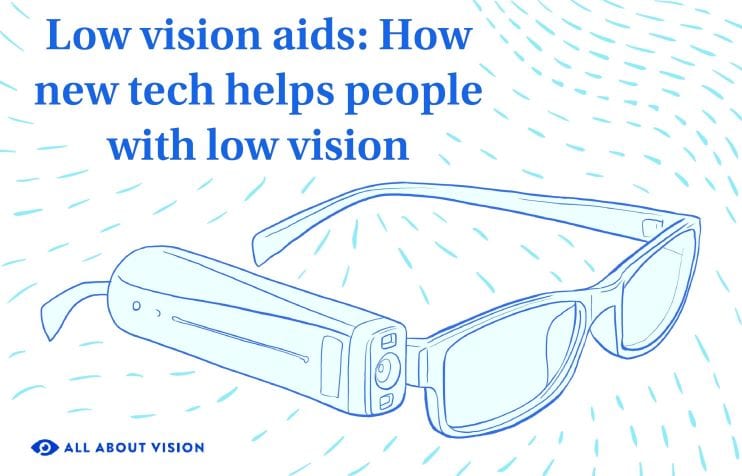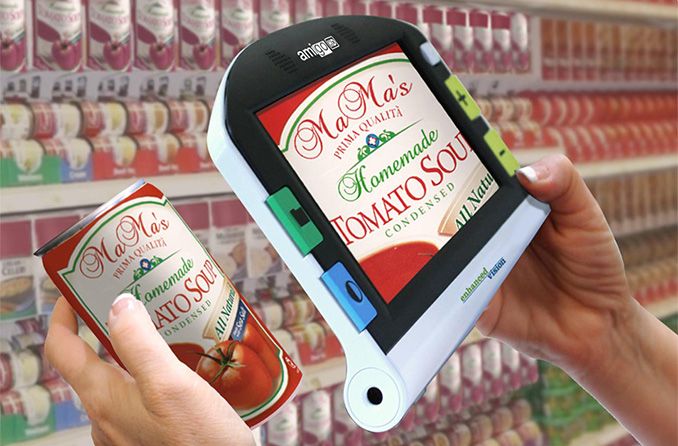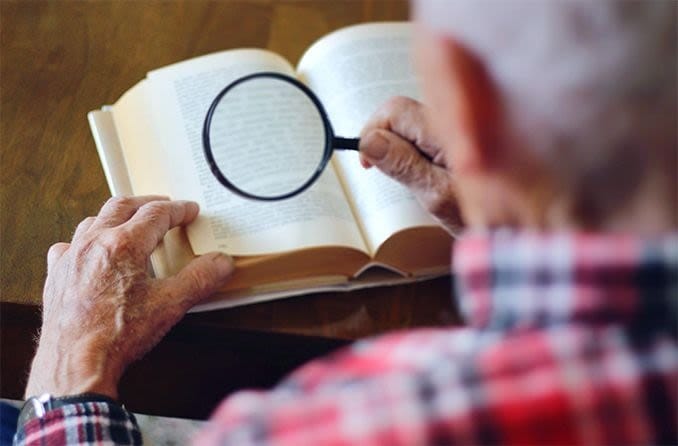Introduction to low vision aids
Low vision aids are specialized tools designed to help people with visual impairments that cannot be corrected with regular glasses, contact lenses or surgery. These devices help maximize a person’s vision, supporting their independence in everyday activities.
Many of today’s low vision aids incorporate innovative technology, making them more advanced than traditional tools like Braille or walking canes. From high-tech video magnifier systems to smart glasses powered by artificial intelligence (AI), these advancements are transforming how people with low vision manage their daily lives.
What is low vision?
Low vision is severe visual impairment caused by injury or various health issues (such as certain eye disorders or stroke). The condition cannot be corrected with glasses, contacts, surgery or other commonly used treatments.
The World Health Organization defines low vision as seeing between 20/70 and 20/400 with best correction (such as glasses or contacts). It also includes people who can see objects only within a limited area, specifically within 20 degrees or less of their peripheral (side) vision.
A person with low vision faces challenges with daily tasks. It can make it difficult to do everyday things, such as:
- Identifying colors
- Recognizing faces
- Seeing screens clearly (such as those on computers, televisions or tablets)
- Reading
- Driving
Low vision is sometimes categorized into types of vision loss, such as:
- Hazy or blurry vision
- Night blindness
- Loss of central vision
- Loss of peripheral vision
Types of low vision aids
The use of low vision technology allows visually impaired individuals to make better use of their remaining vision. These aids include:
Optical devices
Optical devices are instruments that use light and magnification to help people with low vision. They make objects appear larger and brighter so they can see details more clearly. Individuals with low vision often rely on them for tasks like reading, writing and recognizing faces. These devices include:
- Handheld magnifiers – Small magnifying lenses that you hold in your hand to make printed words or pictures look bigger. Some may include built-in lighting.
- High-powered magnification spectacles – Strong reading glasses with thick lenses that bring close-up items into focus. Objects must be held very close to the face when using these.
- Binoculars and distance telescopes – Magnifying devices, including those mounted on glasses or that are handheld. These help people see things clearly farther away, like street signs.
- Stand magnifiers – Devices that sit on a page or table and stay steady while you read. These devices sometimes have built-in lights to improve contrast.
- Telemicroscopic glasses – Glasses that combine the features of a telescope and a microscope. They allow people to clearly see close-up objects while maintaining a comfortable distance. These glasses are helpful when working on a computer, doing crafts or cooking. They can be made for one eye or both eyes.
Electronic devices
Technology provides powerful electronic tools to help people with visual impairment. These digital devices can make it easier to read, write and perform other tasks.
Digital tools are cost-effective and portable options for many people and can make a significant difference in their everyday lives.
Here’s how different types of electronic low vision aids work:
Video magnifiers
Video magnifiers use a camera and a screen to magnify objects, such as printed materials or photographs. You can:
- Zoom in on text or pictures
- Adjust the brightness and contrast
- Have the text read out loud (in some models)
Video magnifiers are available in portable and desktop versions, allowing them to be used at home, in school or on the go.
Audiobooks and eBooks
Audiobooks read the text out loud, so you can listen instead of reading. eBooks (such as Kindle, Nook or Kobo) make reading easier by letting you adjust the font size and background contrast.
AI reading tools make it possible to access printed text instantly through audio or digital formats. These tools offer a wider range of accessible reading materials compared to traditional Braille books. While Braille materials are still effective, they’re often bulkier, harder to find and not always available in public spaces.
Optical character recognition (OCR) devices
OCR tools scan printed text and then read it back to you. You can use OCR devices in different forms, including:
- Those built into eyeglasses or a headset
- As part of a computer or tablet
- As a stand-alone reader
Smartphones and tablets
Most phones and tablets now include vision tools such as those that:
- Zoom or magnify the screen
- Change text size and contrast
- Use voice commands
- Download apps that read aloud, add light or improve viewing
Computers
Many computers have built-in low vision features that:
- Read the text aloud
- Enlarge the screen’s display
- Improve color contrast
Wearable technology
Wearable technology includes electronic devices mounted or worn on the body (such as smart glasses) or those that are implanted, like the bionic eye. Many of these devices incorporate AI technology, helping to make everyday tasks easier and safer.
Some wearable low vision aids include:
Smart glasses
Smart glasses help people with low vision do everyday tasks more easily. They can help you navigate, find objects and understand your surroundings. When paired with tools like Meta’s AI assistant, the glasses can answer your questions, describe what’s around you, name objects and recognize faces. Smart glasses are helpful both at home and outdoors.
Some smart glasses models, such as those designed for people with macular degeneration, use special lenses to focus images on the healthy parts of the retina.
Other models can scan printed text using a built-in camera, convert it into speech and send it directly to the user’s earphones.
Head‑mounted wearable cameras
Small cameras can be worn on eyeglass frames or headsets. They capture what you’re looking at and provide feedback (such as describing objects or helping with navigation).
Wearables with lidar, sonar or radar sensors
These devices use sensors to detect obstacles and map your surroundings. They provide alerts through sound or vibration to help keep you safe when you walk around.
GPS‑enabled navigation glasses
Smart glasses equipped with GPS help users get directions and stay aware of their location. The glasses show street names and can provide guidance in indoor and outdoor environments.
AI-assisted GPS navigation helps users travel safely, even in the dark. It uses AI to detect surroundings and guide users through city streets, which is more effective than using a cane alone.
Body-mounted devices
These gadgets can attach to items like backpack straps. They combine sensors and audio cues to assist with walking, avoiding obstacles or finding objects, allowing your hands to stay free.
Bionic eye
This is a tiny electronic implant placed in the eye through a surgical procedure. It helps people with severe vision loss see light and shapes.
Bionic eyes, although still in developmental stages, show promise for restoring partial sight by bypassing damaged portions of the retina. They are mostly used for retinal diseases like retinitis pigmentosa and age-related macular degeneration (AMD).
Benefits of the latest low vision aids
New and innovative low vision tools are helping people with the condition live more independently. These devices can improve:
- Mobility – Moving around safely
- Safety – Avoiding hazards in daily life
- Independence – Doing tasks without help
- Daily activities – Like reading, cooking and navigating
- Quality of life improvement – Feeling confident and capable
Enhanced daily living
Blindness and low vision can interfere with many activities of daily living, as eyesight is needed to complete most tasks. Low vision assistive technologies include a variety of aids that enhance a person’s function and support them in various daily activities.
Accessibility and ease of use
Modern vision aids are versatile in function. You can choose from handheld or wearable devices and adjust settings such as size, contrast and brightness to suit your needs.
Low vision aids differ in their ease of use. For instance, magnifying glasses and handheld magnifiers are simple to use and great for everyday reading or quick tasks. However, devices like telemicroscopes and electronic magnifiers can be more challenging to use, as they require learning how to position them properly.
Working with a low vision specialist or certified vision rehabilitation professional is very beneficial. They can recommend the best aids for your individual needs and teach you how to use them most effectively.
Choosing the right low vision aid
It’s essential to choose the right low vision aid based on a comprehensive eye exam and your individual needs.
Assessing individual needs
During a low vision exam, the selection of low vision aids will be based on the specific condition, lifestyle and visual goals. For example, someone with AMD might need different tools than a person with glaucoma.
To achieve better acceptance of any aid, a low vision specialist will consider the following factors:
- Daily visual needs
- Visual acuity (as tested by an eye doctor)
- Individual goals
- Ability to use the aid correctly
- Aesthetics (how the vision aid looks)
- Budget
- Comfort
- Prescription timing (when the aid will be most effective)
Professional guidance and services
If you have visual impairment but still have some usable vision, a clinical low vision evaluation can help. This specialized evaluation identifies which tools and devices might make it easier to do everyday things like schoolwork, job duties or activities at home.
Unlike a regular eye exam, which checks eye health, a low vision evaluation focuses on how you use your remaining vision in daily life.
This evaluation includes assessment of :
- Distance vision (seeing far-away objects)
- Intermediate vision (seeing objects at arm’s length, such as when using a computer)
- Near vision (seeing up close, such as when reading or writing)
- Vision used for tasks at school, work and home
- Color vision
- Visual field
- Contrast sensitivity
These exams use special charts and tools designed for people with low vision.
Once you are evaluated, a specialist can help you select the best low vision aid for your condition. They may refer you to a professional who trains people on how to effectively use their low vision aids.
Low vision services may also include:
- Vision rehabilitation consultations
- Device recommendations
- Low vision reading training
- Home safety evaluations
- Navigation support for low vision
Some services are provided at no cost. Others may be covered by insurance or billed through Medicare.
Innovations in low vision technology
The National Eye Institute (NEI) is funding new projects to improve daily life and independence with low vision. A major goal is to support new technology that makes everyday activities more accessible for visually impaired people. With the rapid growth of smart devices, apps and wearable technology, people with vision loss may soon have a much better way to interact with the world.
AI and image processing
AI-powered tools help people with low vision see images more clearly by enhancing key visual elements. These tools can automatically sharpen edges, boost colors and reduce blurry backgrounds. This makes it easier to see what’s in a diagram, photo or piece of art. Improved images can support reading, learning and communicating with others more effectively.
Future trends
The future of technology for low vision aids is promising for many people with vision problems.
Examples of new technology being developed include:
- Mobile apps with three-dimensional (3D) motion sensing to help with indoor navigation
- Smarter, more flexible keyboards and voice-powered tools
- AI-powered screen readers and better image or object recognition
- 3D-printed tactile (able to feel with touch) maps and diagrams for learning and navigation
- Virtual reality systems that use sound or touch to replace visual components
- Advanced braille displays with multiple refreshable lines
Resources and support
There are many resources available to support individuals with low vision, including:
Community and online resources
Support groups, online forums and nonprofit websites offer helpful information and emotional support. These resources help people with visual impairment adjust to daily life, share tips and connect with others facing similar challenges. Some of these include:
National organizations and hotlines
- American Foundation for the Blind (AFB) – Offers information and referrals
- American Macular Degeneration Foundation (AMDF) – Provides support and resources
- American Printing House for the Blind (APH) – Supplies accessible materials
- APH Connect Directory – Features a searchable directory to find low‑vision services near you
Tech accessibility
- Apple accessibility – Provides information for iPhone and Mac users
- Facebook accessibility – Offers Facebook-specific guides and a help center
- Microsoft accessibility tutorials – Offers tutorials for using accessibility features.
- Computers for the Blind (CFTB) – Provides refitted computers for users with low vision
- Google accessibility – Offers tools and resources for using Android, Chrome, Google Workspace and other Google products
Living with low vision
The latest low vision aids are helping people with visual impairment live better lives. From basic magnification tools to advanced smart devices, there are more options than ever. With the right support and tools, people with glaucoma, AMD and other conditions that cause low vision can stay independent and active.
READ NEXT: Typeface designed for low-vision reader







